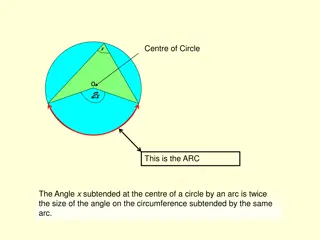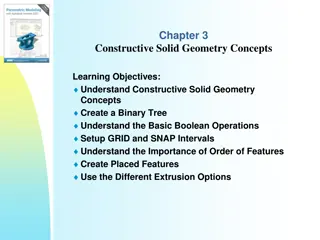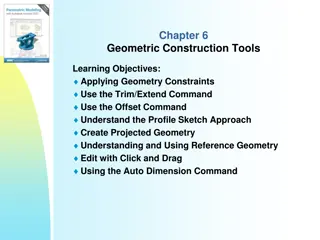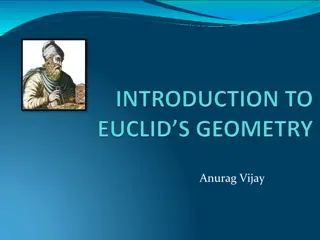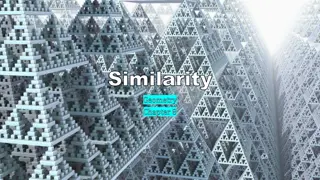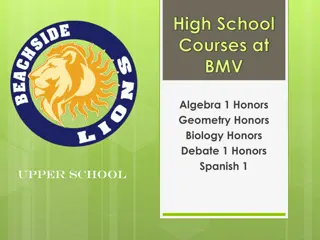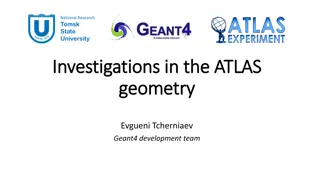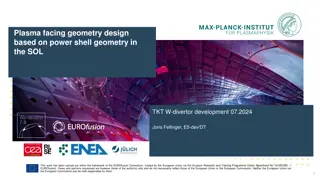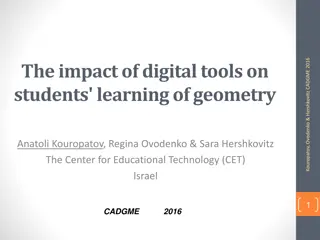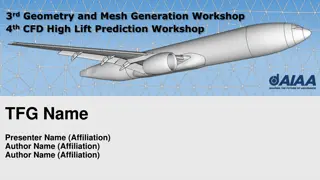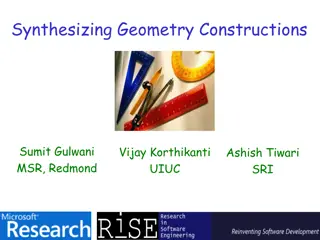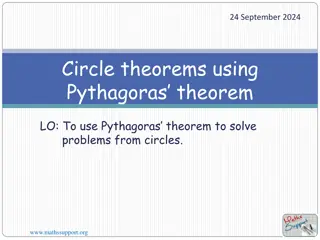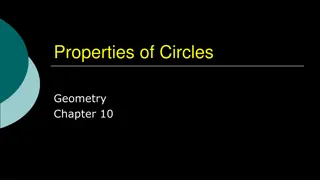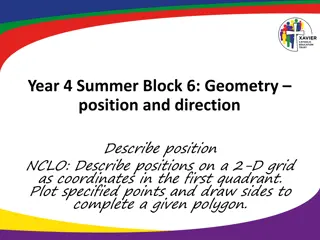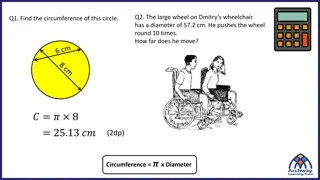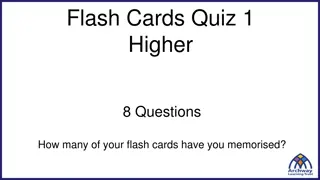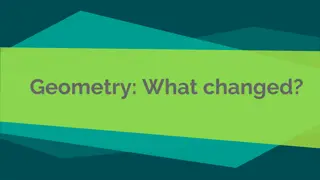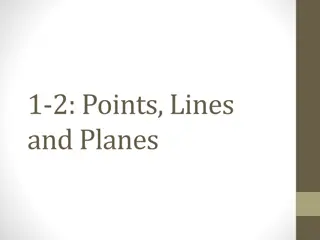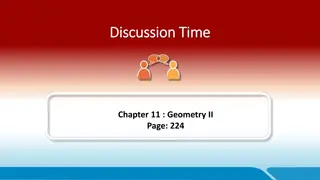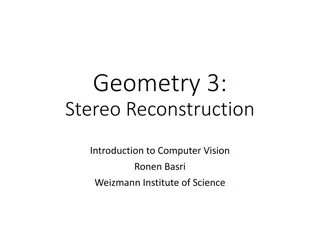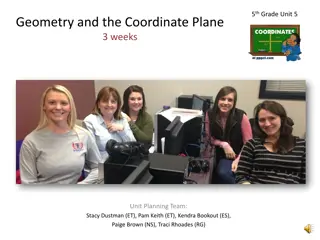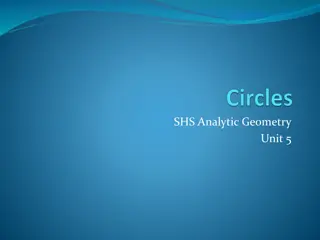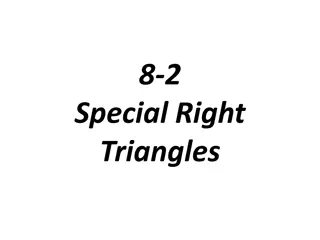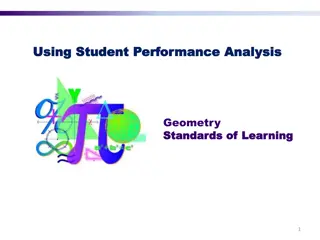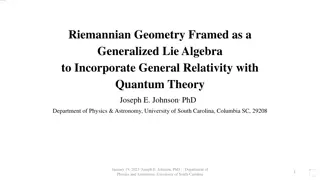Overview of Army Modeling and Simulation Office
The U.S. Army Modeling and Simulation Office (AMSO) serves as the lead activity in developing strategy and policy for the Army Modeling and Simulation Enterprise. It focuses on effective governance, resource management, coordination across various community areas, and training the Army Analysis, Mod
2 views • 8 slides
Circle Geometry Principles
Explore key concepts in circle geometry such as angles subtended at the center and circumference, cyclic quadrilaterals, properties of tangents and chords, and the significance of major and minor segments. Uncover relationships between angles, segments, and points on a circle, including alternate se
2 views • 8 slides
Constructive Solid Geometry Concepts
Explore Constructive Solid Geometry (CSG) concepts including binary tree representation, Boolean operations, base feature selection in parametric modeling, and the importance of order in feature creation. Learn about CSG's role in representing solid models and its applications in the field of solid
1 views • 13 slides
Autodesk Inventor Geometric Construction Tools Overview
Explore the functionality of Autodesk Inventor's geometric construction tools, such as applying geometry constraints, utilizing trim/extend and offset commands, understanding profile sketches, creating projected geometry, and editing sketches with click and drag. Discover how to enhance efficiency i
3 views • 12 slides
Evolution of Modeling Methodologies in Telecommunication Standards
Workshop on joint efforts between IEEE 802 and ITU-T Study Group 15 focused on information modeling, data modeling, and system control in the realm of transport systems and equipment. The mandate covers technology architecture, function management, and modeling methodologies like UML to YANG generat
1 views • 16 slides
Geometric Modeling in CAD
Geometric modeling in computer-aided design (CAD) is crucially done in three key ways: wireframe modeling, surface modeling, and solid modeling. Wireframe modeling represents objects by their edges, whereas surface modeling uses surfaces, vertices, and edges to construct components like a box. Each
1 views • 37 slides
Euclid's Geometry: The Fundamentals Explained
Euclid, known as the Father of Geometry, introduced the principles of geometry in Egypt. His work included definitions, axioms, and postulates that laid the foundation for geometric reasoning. Euclid's Five Postulates are crucial in understanding the basic concepts of geometry. This article provides
2 views • 12 slides
Similar Polygons in Geometry
Explore the concept of similar polygons in geometry through a comprehensive slideshow developed to accompany the textbook "Big Ideas Geometry" by Larson and Boswell. Learn to identify corresponding lengths, perimeters, and areas of similar polygons, make similarity statements, and determine similari
0 views • 24 slides
Diverse High School Courses at BMV: Algebra, Geometry, Biology, Debate, Spanish
Explore a variety of high school courses at BMV including Algebra 1 Honors, Geometry Honors, Biology Honors, Debate, and Spanish 1. These courses offer a comprehensive range of subjects from math to language arts, preparing students for advanced studies and fulfilling graduation requirements. Studen
0 views • 19 slides
Introduction to Dynamic Structural Equation Modeling for Intensive Longitudinal Data
Dynamic Structural Equation Modeling (DSEM) is a powerful analytical tool used to analyze intensive longitudinal data, combining multilevel modeling, time series modeling, structural equation modeling, and time-varying effects modeling. By modeling correlations and changes over time at both individu
2 views • 22 slides
Insights from Geant4 Development Team on ATLAS Geometry Investigations
Investigating the ATLAS geometry using Geant4, the team from National Research Tomsk State University presented findings at the 23rd Geant4 Collaboration Meeting. They focused on solid methods, CPU consumption, and optimizing geometry descriptions to enhance simulation performance. Specifics of the
0 views • 40 slides
Practical Geometry Guide by S.N. Mishra
Practical Geometry Made by S.N. Mishra is a comprehensive guide that covers various aspects of practical geometry with detailed explanations and visual aids. The guide includes step-by-step instructions, illustrations, and practical examples to help users grasp the concepts easily. Whether you are a
1 views • 12 slides
System Modeling and Simulation Overview
This content provides insights into CPSC 531: System Modeling and Simulation course, covering topics such as performance evaluation, simulation modeling, and terminology in system modeling. It emphasizes the importance of developing simulation programs, advantages of simulation, and key concepts lik
1 views • 28 slides
Object Modeling in Software Development
Object modeling is a crucial concept in software development, capturing the static structure of a system by depicting objects, their relationships, attributes, and operations. This modeling method aids in demonstrating systems to stakeholders and promotes a deeper understanding of real-world entitie
1 views • 65 slides
Geometry Test Prep Questions
Prepare for your geometry test by reviewing essential questions on points, lines, planes, distances, and intersections. Use the provided images to practice concepts such as collinear points, intersecting lines, opposite rays, and more. Challenge yourself to solve distance problems without using form
1 views • 31 slides
Coupled Ocean-Atmosphere Modeling on Icosahedral Grids
Coupled ocean-atmosphere modeling on horizontally icosahedral and vertically hybrid-isentropic/isopycnic grids is a cutting-edge approach to modeling climate variability. The design goals aim to achieve a global domain with no grid mismatch at the ocean-atmosphere interface, with key indicators such
3 views • 21 slides
Development of Plasma-Facing Geometry Design for W-Divertor in SOLTKT Fusion Reactor
Study on the plasma-facing geometry design based on power shell geometry in the SOL TKT W-divertor development for the fusion reactor. The research involves fundamental differences in divertor baffle design, materials used, heat load requirements, interface connections, and key design concerns. The
0 views • 14 slides
Introduction to Priority Search Trees in Computational Geometry
This lecture outlines the structure and query process of Priority Search Trees (PST) in computational geometry. It covers heap-based point queries, range trees for windowing queries, handling query ranges in 1D and 2D spaces, and using heaps to efficiently handle query ranges. The content discusses
1 views • 18 slides
The Impact of Digital Tools on Geometry Learning
This study explores how digital tools influence students' learning of geometry through an interactive online course developed by The Center for Educational Technology. The course focuses on concept development, tool utilization, and cognitive paths in geometry education. Research findings emphasize
0 views • 14 slides
Conditional Statements in Geometry
In this chapter of "Big Ideas Geometry," the focus is on conditional statements in geometry. Learn how to write conditional and biconditional statements, determine if statements are true or false, and explore logical implications such as converse and negation. Through examples and explanations, gras
0 views • 54 slides
Advancing Computational Modeling for National Security and Climate Missions
Irina Tezaur leads the Quantitative Modeling & Analysis Department, focusing on computational modeling and simulation of complex multi-scale, multi-physics problems. Her work benefits DOE nuclear weapons, national security, and climate missions. By employing innovative techniques like model order re
0 views • 6 slides
CFD Workshop on Geometry Generation and Meshing Techniques
This workshop focused on the use of geometry modeling and mesh generation techniques in Computational Fluid Dynamics (CFD) simulations. Participants discussed key questions, findings, lessons learned, supporting evidence, and future plans relating to geometry manipulation, mesh quality, and the impa
0 views • 8 slides
Geometry Constructions: A Synthesis of Theory and Practice
Explore the world of geometry constructions through ruler/compass-based techniques, combining logical reasoning and visual elements to create engaging exercises. Discover the programming language for constructing geometric shapes, with an example problem and a specification language for geometry pro
0 views • 25 slides
Geometry Concepts and Calculations Practice Questions
This content covers various topics in geometry, including decimal and fraction conversions, percentage calculations, along with missing angle calculations. It offers practice questions for students to enhance their understanding of geometry concepts.
0 views • 11 slides
Basics of Geometry: Understanding Points, Lines, and Planes
Explore the fundamental concepts of geometry in this slideshow developed to accompany the textbook "Big Ideas Geometry." Learn about points, lines, and planes, their characteristics, how they are named, and their relationships in space. Gain a clear understanding of line segments, rays, collinear po
1 views • 55 slides
Circle Theorems and Pythagoras Theorem in Geometry
Explore the key concepts of circle theorems and Pythagoras theorem in geometry. Learn about the parts of a circle, properties of chords, the relationship between the radius and tangent, and how Pythagoras theorem can be applied to solve circle-related problems like finding distances and lengths. Eng
0 views • 8 slides
Properties of Circles in Geometry
Explore the key concepts and properties related to circles in geometry, such as tangents, diameters, secants, and common tangents. Discover how tangents interact with circles and learn about the relationships between radius, diameter, and chord lengths. Enhance your understanding of circle geometry
0 views • 48 slides
Geometry Positions and Directions in Year 4 Summer Block 6
Delve into the world of geometry positions and directions through Year 4 Summer Block 6 activities. Learn to describe positions on a 2-D grid, plot points, draw polygons, understand coordinates in the first quadrant, and perform movements on a grid. Enhance your skills in fluency, reasoning, and pro
0 views • 29 slides
Circumference and Perimeter Calculations in Geometry
Explore various geometry problems involving calculating circumferences and perimeters of shapes and circles. Practice calculating diameters, radii, and distances moved in real-life scenarios. Test your knowledge with true or false questions related to geometry concepts.
0 views • 12 slides
Higher Level Flash Cards Quiz - Geometry and Mathematics
This set of flash cards quizzes your knowledge on various geometry and mathematics topics. From calculating exterior angles of polygons to determining the area of shapes and understanding correlations in graphs, test your understanding and learn new concepts. Sharpen your skills in geometry, trigono
0 views • 15 slides
Changes in Geometry Standards: A Comprehensive Overview
Delve into the shifts in geometry standards, including changes in language, concepts like composing and decomposing shapes, and new instructional strategies. Explore the progression of standards from second to fourth grade, vocabulary considerations, and professional learning opportunities for enhan
0 views • 9 slides
Introduction to Points, Lines, and Planes in Geometry
Exploring the fundamental concepts of points, lines, and planes in geometry, including definitions, examples, and postulates. Learn about collinear points, coplanar points, segments, rays, and key postulates in geometry.
0 views • 18 slides
Geometry II - Understanding Lines and Arcs in a Circle
This content discusses concepts related to geometry, focusing on lines and arcs within a circle. It explores the properties of lines AB and APB, measures of angles AOB and APB, as well as the shapes formed within the circle. The discussion provides a clear understanding of the terminology and geomet
1 views • 4 slides
Introduction to Stereo Reconstruction in Computer Vision
This material covers the fundamental concepts in stereo reconstruction, including the pinhole camera model, perspective projection, epipolar geometry, essential and fundamental matrices, camera calibration, homography, and projective geometry. It also discusses stereo vision and 3D reconstruction fr
0 views • 41 slides
Geometry and Coordinate Plane in 5th Grade
Delve into the world of geometry and the coordinate plane with 5th-grade students. The unit focuses on graphing on the coordinate grid, properties of shapes, real-world problem-solving, and numerical patterns. Students will classify shapes, plot points, and explore multiplication and division concep
0 views • 15 slides
NetLogo - Programmable Modeling Environment for Simulating Natural and Social Phenomena
NetLogo is a powerful and versatile programmable modeling environment created by Uri Wilensky in 1999. It allows users to simulate natural and social phenomena by giving instructions to multiple agents operating independently, making it ideal for modeling complex systems evolving over time. NetLogo
0 views • 7 slides
Circles in Analytic Geometry
Explore the fundamentals of circles in analytic geometry by learning how to derive circle formulas, equation determination, completing the square, proving circle properties, and solving application problems. Discover the definition of a circle, its relation to triangles, and the terms, equations, an
0 views • 51 slides
Geometry Problems and Solutions
Explore a series of geometry problems involving special right triangles, hypotenuse lengths, leg measurements, and applications of triangle theorems. From finding the length of the hypotenuse to distance calculations on a softball diamond, challenge your geometry skills with these engaging problems.
0 views • 9 slides
Geometry Standards of Learning Practice Problems
Explore practice problems related to Geometry Standards of Learning (SOL), covering topics such as symbolic representation of arguments, laws of detachment, contrapositive, syllogism, counterexamples, and geometric proofs. Test your understanding of angles, lines, transversals, and congruence to str
0 views • 50 slides
Incorporating General Relativity into Quantum Theory through Riemannian Geometry
Framing Riemannian Geometry as a Generalized Lie Algebra to combine General Relativity with Quantum Theory. The proposal extends Heisenberg Algebra to incorporate a more general geometry, allowing for a function of position in commutator relationships. The discussion covers historical developments,
0 views • 50 slides

